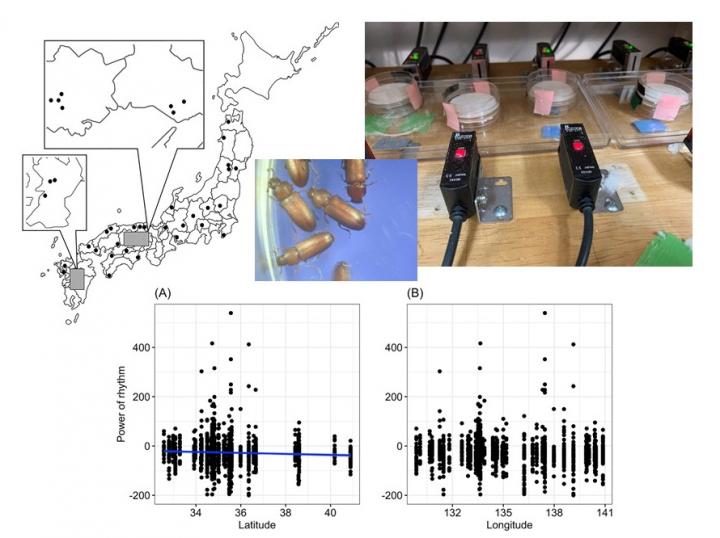Scientists explore geographical variation in the biological clock of a new model organism, the Japanese red flour beetle

Credit: 2021 Okayama University
One of the most intriguing features in all living beings is the “biological clock”, an internal time-keeping mechanism that governs our behavioral pattern (such as the sleep-wake cycle). In fact, the biological clock dictates the developmental timing of various processes, such as when flowers bloom and insects reproduce. Biologists refer to these activities collectively as “circadian rhythms,” owing to the rhythmic pattern in which they occur.
Since their discovery, circadian rhythms have been studied extensively, and today we know a great deal about how they work. But, it is still not understood why, in some species, these rhythmic traits can vary based on geographical location (also called “cline”). While studies focusing on the relationship between the strength of “amplitude” of the rhythm (time variation in the level of a particular measure, such as activity level) and latitude (variation between north and south) have been conducted in fruit flies, the findings are contradictory.
In a new study published in PLoS One, scientists in Japan, led by Prof. Takahisa Miyatake from Okayama University, decided to explore the problem using a new biological model: the red flour beetle, a common insect found throughout Japan. He explains, “Organisms living in northern and southern countries should have different rhythm traits and it would be interesting to know why these differences exist. We came up with the idea that such geographical variation in traits could be easily studied in the red flour beetle, which can be collected in a wide range of latitudes from all over the country.”
Accordingly, the scientists collected red flour beetles from 37 rice mills in different parts of Japan and nurtured them under laboratory conditions emulating their natural environment. After an initial nurturing period of 20 days, they assessed the circadian rhythm of individual beetles (more than 1500 samples) by monitoring their locomotor activity (movement) for 10 days.
The findings showed that the rhythm strength decreased with increasing latitude such that beetles from the northern parts showed weaker circadian rhythms than their southern counterparts. However, changing longitudes (east to west) showed no significant difference. Interestingly enough, despite the large sample size, they did not observe any variation in the rhythm period with latitude or longitude, which contradicted the findings of previous studies.
The scientists ascribed the weaker rhythmic amplitude at higher altitudes to its more extreme and harsh environments, which possibly had more influence on the beetle’s behavior than its biological clock. As for the unchanging rhythm period with location, they speculated that the flow of genetic material from one beetle population to another was likely more than hypothesized, thus washing out their genetic differences and leading to uniform rhythm periods.
Prof. Miyatake is excited by these findings and their possible implications. He concludes, “Many insects are expanding their distribution areas to the north due to global warming, and the nature of their circadian rhythms may change accordingly. We may be able to open up a new research field to see if the nature of variation in the biological clock of insects is also applicable to humans!”
Does this mean our bodies might be working in a certain way depending on our location? We don’t entirely know yet, but hopefully, future studies will reveal a lot more.
###
Media Contact
Takahisa Miyatake
[email protected]
Related Journal Article
http://dx.




